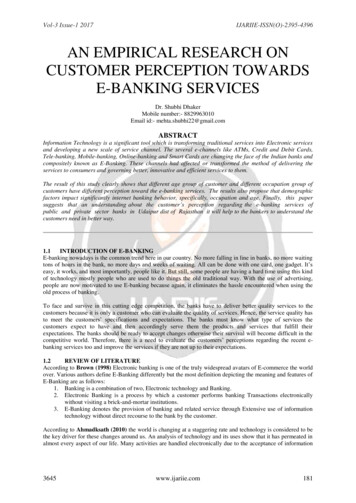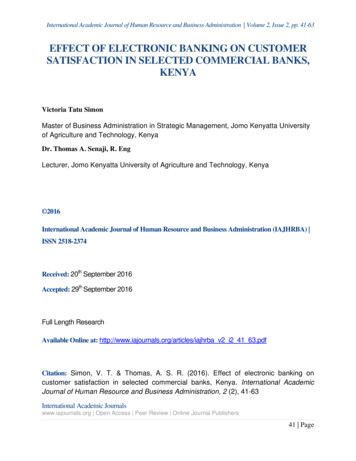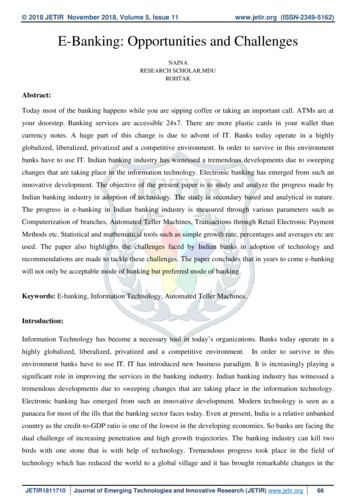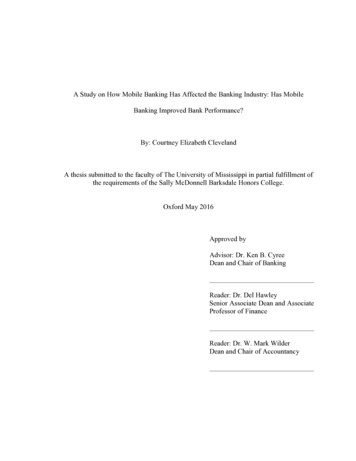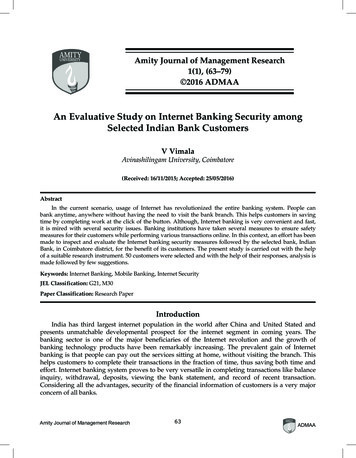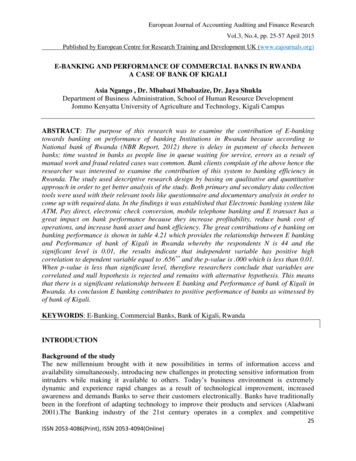
Transcription
European Journal of Accounting Auditing and Finance ResearchVol.3, No.4, pp. 25-57 April 2015Published by European Centre for Research Training and Development UK (www.eajournals.org)E-BANKING AND PERFORMANCE OF COMMERCIAL BANKS IN RWANDAA CASE OF BANK OF KIGALIAsia Ngango , Dr. Mbabazi Mbabazize, Dr. Jaya ShuklaDepartment of Business Administration, School of Human Resource DevelopmentJommo Kenyatta University of Agriculture and Technology, Kigali CampusABSTRACT: The purpose of this research was to examine the contribution of E-bankingtowards banking on performance of banking Institutions in Rwanda because according toNational bank of Rwanda (NBR Report, 2012) there is delay in payment of checks betweenbanks; time wasted in banks as people line in queue waiting for service, errors as a result ofmanual work and fraud related cases was common. Bank clients complain of the above hence theresearcher was interested to examine the contribution of this system to banking efficiency inRwanda. The study used descriptive research design by basing on qualitative and quantitativeapproach in order to get better analysis of the study. Both primary and secondary data collectiontools were used with their relevant tools like questionnaire and documentary analysis in order tocome up with required data. In the findings it was established that Electronic banking system likeATM, Pay direct, electronic check conversion, mobile telephone banking and E transact has agreat impact on bank performance because they increase profitability, reduce bank cost ofoperations, and increase bank asset and bank efficiency. The great contributions of e banking onbanking performance is shown in table 4.21 which provides the relationship between E bankingand Performance of bank of Kigali in Rwanda whereby the respondents N is 44 and thesignificant level is 0.01, the results indicate that independent variable has positive highcorrelation to dependent variable equal to .656** and the p-value is .000 which is less than 0.01.When p-value is less than significant level, therefore researchers conclude that variables arecorrelated and null hypothesis is rejected and remains with alternative hypothesis. This meansthat there is a significant relationship between E banking and Performance of bank of Kigali inRwanda. As conclusion E banking contributes to positive performance of banks as witnessed byof bank of Kigali.KEYWORDS: E-Banking, Commercial Banks, Bank of Kigali, RwandaINTRODUCTIONBackground of the studyThe new millennium brought with it new possibilities in terms of information access andavailability simultaneously, introducing new challenges in protecting sensitive information fromintruders while making it available to others. Today’s business environment is extremelydynamic and experience rapid changes as a result of technological improvement, increasedawareness and demands Banks to serve their customers electronically. Banks have traditionallybeen in the forefront of adapting technology to improve their products and services (Aladwani2001).The Banking industry of the 21st century operates in a complex and competitive25ISSN 2053-4086(Print), ISSN 2053-4094(Online)
European Journal of Accounting Auditing and Finance ResearchVol.3, No.4, pp. 25-57 April 2015Published by European Centre for Research Training and Development UK (www.eajournals.org)environment characterized by these changing conditions and highly unpredictable economicclimate. Information and Communication Technology (ICT) is at the centre of this global changecurve of Electronic Banking System in Africa today (Stevens 2002). Assert that they have overthe time, been using electronic and telecommunication networks for delivering a wide range ofvalue added products and services, managers in Banking industry in Rwanda cannot ignoreInformation Systems because they play a critical impact in current Banking system, they pointout that the entire cash flow of most fortune Banks are linked to Information System.Theapplication of information and communication technology concepts, techniques, policies andimplementation strategies to banking services has become a subject of fundamental importanceand concerns to all banks and indeed a prerequisite for local and global competitivenessBanking.The advancement in Technology has played an important role in improving service deliverystandards in the Banking industry. In its simplest form, Automated Teller Machines (ATMs) anddeposit machines now allow consumers carry out banking transactions beyond bankinghours.With online banking, individuals can check their account balances and make paymentswithout having to go to the bank hall. This is gradually creating a cashless society whereconsumers no longer have to pay for all their purchases with hard cash hence improvingcustomer relationship management system. For example: bank customers can pay for airlinetickets and subscribe to initial public offerings by transferring the money directly from theiraccounts, or pay for various goods and services by electronic transfers of credit to the sellersaccount. As most people now own mobile phones, banks have also introduced mobile banking tocater for customers who are always on the move. Mobile banking allows individuals to checktheir account balances and make fund transfers using their mobile phones. This was popularizedin Rwanda first by Bank of Kigali; customers can also recharge their mobile phones via SMS. EBanking has made banking transactions easier around the World and it is fast gaining acceptancein Rwanda. For the purpose of this study the researcher has chosen Bank of Kigali Rwanda Ltdas a case study in order to study the contribution of e-banking to banking efficiency orperformance in Rwanda.Statement of ProblemAccording to National bank of Rwanda (NBR Report, 2012) there is delay in payment of checksbetween banks; time wasted in banks as people line in queue waiting for service, errors as aresult of manual work and fraud related cases was common. As a result some clients complain ofthe above, it is upon this that is why the researcher would like to examine the contribution of Ebanking towards banking on performance of banking Institutions because researcher believesthat adoption of electronic banking will ease banking transactions and woe customers basing onexperience from other developed countries.Objectives of the StudyThe purpose of this research was to examine the contribution of E-banking towards banking onperformance of banking Institutions in Rwanda.Specific objectivesi.To identify e-banking tools used by Bank of Kigali.ii.To analyze performance of bank of Kigali before and after adoption of e banking system.26ISSN 2053-4086(Print), ISSN 2053-4094(Online)
European Journal of Accounting Auditing and Finance ResearchVol.3, No.4, pp. 25-57 April 2015Published by European Centre for Research Training and Development UK (www.eajournals.org)iii.To identify challenges faced by the banks while using e banking system.Research questionsi.What are e-banking tools used by Bank of Kigali?ii.How e banking affected performance of bank of Kigali before and after adoption of ebanking system?iii.What are the challenges faced by the banks while using e banking system?Scope of the StudyThis research sought to examine the impact of E banking on performance of bank of Kigali inRwanda. The study will be conducted in Bank of Kigali headquarters in Kigali City. Theresearcher will analyze E banking and performance of bank of Kigali for a period of four years(2010 - 2013), since when e commerce became fully recognized in banking institutions inRwanda.Profile of Bank of KigaliBank of Kigali (BK) is a commercial bank in the Republic of Rwanda. The bank is one of thecommercial banks licensed by the National Bank of Rwanda, the country’s banking regulator.Bank of Kigali was started in 1966 to provide commercial banking services to individuals, smallbusinesses and large corporations.VisionBank of Kigali aspires to be the leading provider of most innovative financial solutions in theregion.MissionThe Mission is to be the leader in a creating value for our stakeholders by providing the bestfinancial services to businesses and individual customers, through motivated and professionalstaffs.The Bank has 33 branches in Rwanda, 15 branches are in Kigali City and the district has18branches. It is one of the most dominant bank in Rwanda due to its sustained performance andgrowth in loans and deposits, which has seen the bank increase its branches and agencies all overthe country. Bank of Kigali produces the following products: Loans, checking, savings,investments, debit cards.REVIEW OF RELATED LITERATUREThis chapter gave overall view of earlier works and theories in areas of the contribution of Ebanking towards banking on performance of banking Institutions in Rwanda. This sectionattempts to present a critical review of the available literature on the subject of research. Itpresents the historical element of E-banking, it looks at different E-banking tools used, andreviews E-banking towards banking on performance of banking.Theoretical ReviewThe concept of e-banking is a delivery channel for banking services. Banks have used electronicchannels for years to communicate and transact business with both domestic and international27ISSN 2053-4086(Print), ISSN 2053-4094(Online)
European Journal of Accounting Auditing and Finance ResearchVol.3, No.4, pp. 25-57 April 2015Published by European Centre for Research Training and Development UK (www.eajournals.org)corporate customers. With the development of the Internet and the World Wide Web (WWW) inthe latter half of the 1990s, banks are increasingly using electronic channels for receivinginstructions and delivering their products and services to their214customers. This form ofbanking is generally referred to as e-banking or Internet banking, although the range of productsand services provided by banks over the electronic channel vary widely in content, capability andsophistication. E-banking is defined as the automated delivery of new and traditional bankingproducts and services directly to customers through electronic, interactive communicationchannels. The definition of e-banking varies amongst researches partially because electronicbanking refers to several types of services through which bank customers can requestinformation and carry out most retail banking services via computer, television or mobile phone(Daniel, 1999; Sathye, 1999). Salehi and Zhila, (2008), describes e-banking as an electronicconnection between bank and customer in order to prepare, manage and control financialtransactions. Electronic banking can also be defined as a variety of following platforms: (i)Internet banking (or online banking), (ii) telephone banking, (iii) TV-based banking, (iv) mobilephone banking, and e-banking (or offline banking).E-banking includes the systems that enable financial institution customers, individuals orbusinesses, to access accounts, transact business, or obtain information on financial products andservices through a public or private network, including the Internet or mobile phone. Customersaccess e-banking services using an intelligent electronic device, such as a personal computer(PC), personal digital assistant (PDA), automated teller machine (ATM), kiosk, or Touch Tonetelephone. While some literature restricts the use of the term to internet banking (Daniel 1999),elsewhere the term is limited to retail banking or both retail and corporate banking (Simpson2002). Banking Supervision (1998), “e-banking refers to the provision of retail and small valuebanking products and services through electronic channels. Such products and services caninclude deposit-taking, lending, account management, the provision of financial advice,electronic bill payment, and the provision of other electronic payment products and services suchas electronic money”.Electronic banking has long been recognized to play an important role in economic developmenton the basis of their ability to create liquidity in the economy through financial intermediationbetween savers and borrowers. It also offers financial services and products that acceleratesettlement of transactions and in the process reduce cash intensity in the financial system,encourage banking culture, and catalyses economic growth (Al-Gahtani, 2001).However, for theeffective functioning of the financial system, the payment systems must be safe and efficient;otherwise they can be a channel for the transmission of disturbances from one part of theeconomy or financial system to others. This is why central banks have been active in promotingsound and efficient payments system and in seeking the means to reduce risks associated withthe system (Al-Gahtani, 2001).Rwanda historically operated a cash-driven economy particularly in the consumer sector,however the system has witnessed improvements over the years, and particular in recent timeshas moved from its rudimentary level of the early years of banking business to the current stateof sophistication comparable to other economies at the same level of development.One importantreason for financial liberalization and deregulation is the need to develop a good payment system28ISSN 2053-4086(Print), ISSN 2053-4094(Online)
European Journal of Accounting Auditing and Finance ResearchVol.3, No.4, pp. 25-57 April 2015Published by European Centre for Research Training and Development UK (www.eajournals.org)which promotes an appropriate mechanism for efficiency in mobilizing and allocating financialresources in the economy. The payment system occupies an important place in the developmentof a country economy, in fact the level of development of a countries payment system is areflection of the state or condition of the country’s economy (Aladwani 2001).Rwanda payment system is paper-based and this accounts for the high level of cash in theeconomy (cash outside bank), the concept “payment system” has different meanings amongwriters the definition range from a more simple to a more complex definition. According toReport on the survey of developments in the e-payments and services products of banks andother financial institutions in Rwanda payment system is defined as a system which consists ofnet works which link members, the switches for routing message and rules and procedures forthe use of its infrastructure (NBR, 2008).Anyanwaokoro (1999), in theory and policy of money and banking, payment system is definedas a system where settlement of financial obligations are done by the use of credit cards or evenpressing some bottoms that transfer the amount in their bank to the account of another personthrough the computer. According to Orjih (1999) a payment system is defined as one whichconsists of different methods of payments which are checks, credit cards, Bankers drafts,standing order, documentary credits swift etc for the settlement of transactions.Application of Electronic BankingFor many consumers, electronic banking means 24-hour access to cash through an automatedteller machine (ATM) or Direct Deposit of paychecks into checking or savings accounts. Butelectronic banking involves many different types of transactions (Simpson 2002, Fox and Beier,2006). According to Simpson (2002), Fox and Beier (2006), Electronic fund transfer (EFT) is acomponents of electronic banking uses computer and electronic technology as a substitute forchecks and other paper transactions. EFTs is initiated through devices like cards or codes that letyou, or those you authorize, access your account (Fox and Beier, 2006). Many financialinstitutions use ATM or debit cards and Personal Identification Numbers (PINs) for this purpose.Some use other types of debit cards such as those that require, at the most, your signature or ascan. For example, some use radio frequency identification (RFID) or other forms of“contactless” technology that scan your information without direct contact. The federalElectronic Fund Transfer Act (EFT Act) covers someelectronic consumer transactions (Simpson2002, Fox and Beier, 2006).ATMs are electronic terminals that let you bank almost any time. To withdraw cash, makedeposits, or transfer funds between accounts, you generally insert an ATM card and enter yourPIN. Some financial institutions and ATM owners charge a fee, particularly if you don’t have accounts with them or if you engage in transactions at remote locations. Generally, ATMs must tellyou they charge a fee and its amount on or at the terminal screen before you complete thetransaction. Check the requirements with your institution and at ATMs you use for moreinformation about these fees (Simpson 2002). Direct Deposit lets you authorize specific deposits,(like paychecks and Social Security check and other benefits) to your account on a regular basis.You also may pre-authorize direct withdrawals so that recurring bills (like insurance premiums,mortgages, utility bills, for Consumers) are paid automatically. Be cautious before you pre29ISSN 2053-4086(Print), ISSN 2053-4094(Online)
European Journal of Accounting Auditing and Finance ResearchVol.3, No.4, pp. 25-57 April 2015Published by European Centre for Research Training and Development UK (www.eajournals.org)authorize direct recurring withdrawals to pay companies you aren’t familiar with; funds fromyour bank account could be withdrawn improperly. Also monitor your bank account to ensurethat direct recurring payments from your account to others are for the correct amount (Simpson2002).Pay-by-Phone Systems let you call your financial institution with instructions to pay certain billsor to transfer funds between accounts. You must have an agreement with the institution to makesuch transfers (Simpson 2002). Personal Computer Banking lets you handle many bankingtransactions via your personal computer. For instance, you may use your computer to view youraccount balance, request transfers between accounts, and pay bills electronically (Simpson2002). Debit Card Purchase or Payment Transaction let you make purchases or payments with adebit card, which also may be your ATM card. This could occur at a store or business, online, orby phone. The process is similar to using a credit card, with some important exceptions (Fox andBeier, 2006). While the process is fast and easy, a debit card purchase or payment transfer’smoney – fairly quickly – from your bank account to the company’s account. So it’s importantthat you have funds in your account to cover your purchase. This means you need to keep accurate records of the dates and amounts of your debit card purchases, payments, and ATMwithdrawals. Also be sure you know the store or business before you provide your debit cardinformation to avoid the possible loss of funds through fraud. Your liability for unauthorized use,and your rights for error resolution, may be different for a debit card than a credit card (Simpson2002).Electronic Check Conversion converts a paper check into an electronic payment or when acompany receives your check in the mail (Fox and Beier, 2006). When you give your check to acashier, the check is run through an electronic system that captures your banking information andthe amount of the check. You’re asked to sign a receipt and you get a copy for your records.When your check is handed back to you, it should be voided or marked by the merchant so that itcan’t be used again. The merchant electronically sends information from the check (but not thecheck itself) to your bank or other financial institution, and the funds are transferred into themerchant’s account. When you mail-in a check for payment to a merchant or other company,they may electronically send information from your check (but not the check itself) through thesystem, and the funds are transferred from your account into their account. For a mailed check,you should still receive advance notice from a company that expects to send your checkinformation through the system electronically. For example, the merchant or other companymight include the notice on your monthly statement. The notice also should state if the merchantor company will electronically collect from your account a fee – like a “bounced check” fee – ifyou have insufficient funds to cover the transaction (Simpson 2002).Where should the real e-banking be?First of all the bank must fully understand and appreciate the fact that the banking industry nowexist, in a global village. It must therefore strive to provide local and global banking servicesusing the infrastructure of the global village. Most current E-banking applications use theinternet. The advantages of on line banking are in providing convenience and flexibility for30ISSN 2053-4086(Print), ISSN 2053-4094(Online)
European Journal of Accounting Auditing and Finance ResearchVol.3, No.4, pp. 25-57 April 2015Published by European Centre for Research Training and Development UK (www.eajournals.org)customers (Anyawaokoro, 1999). Some online banking allows customers to get current accountbalances at any time. Customers do not need to wonder whether a check of has cleared or adeposit has been posted. At the click of a button, customers can easily check the status of theircurrent savings and money-market accounts through online banking. Banks can provideimmediate account enquires or statements online for customers (Casalo et al, 2007).a.InternetMost of the applications mentioned involved the use of internet, E-banking is more than justInternet banking in the still evolving e-climate in the economy; it involves using the net toexploit new opportunities by transforming products and markets and business processes (Fox andBeier, 2006). E-banking also means developing new relationship with customers, regulatoryauthorities’, suppliers and banking partners with digital age tools, for example, it requires allunderstanding. Customer/bank relationships will be more personalized resulting in novel modesof transaction processing and services delivery. E-banking is essentially about banks using newage methods and tools to expand into new banking markets and grow. Creating a corporateonline presence for your bank should be more than just buildings a website. It should be aboutbuilding a web business for your bank, to do this effectively the people in charge, i.e. the CEOsnot just IT directors and managers must have a deep knowledge of what E-banking culturedemands (Clive, 2007).b.E-businessIT or E-business or E-commerce is not about routine information management or automation, itis about using these unique tools to create opportunities, create new markets, new processes andgrowth or increase the creation of e- wealth (Hampton-Sosa et al. 2005). E-banking monitors theenvironment local and global with the aim of understanding and mastering its environment. Ebanking thus involves collaboration (local and international) on payments systems, cashlesstransactions, digital cash and other electronic based projects.It can be seen that other immensepotentials can only be realized if bank management and staff, not just the systems staff aresufficiently literate and aware, and presently the banking industry still has a lot to do in terms oftraining staff. The speed of change together with the need for proper orientation for the e-worldmakes training even more of a necessity (Usman, 1998).For E-banking to be effective, an area that must be addressed is security, for any IT based serviceassociated with e-banking increases the need for security, in e-banking the core security areasshould be addressed. A key concern is that of privacy. Business on the net cannot be undertakenwithout addressing the privacy concerns of people you do business with. It requires the existenceof a privacy policy. No customer wants to click away to a negative balance. Security in onlinebanking is typically provided through the use of an electronic Identity (ID) and password. Theseand other security measures must be effective to prevent not only the breach of privacy, but othersecurity concerns like the alteration of data (Hampton-Sosa et al. 2005).In conclusion to be a true E-bank each bank must identify its own unique targets, focus and style.Banks needs to realize that E-banking is more than simply banking on the internet, E-banking ismore than having a web-site, E-banking is about building a web business for your banks.31ISSN 2053-4086(Print), ISSN 2053-4094(Online)
European Journal of Accounting Auditing and Finance ResearchVol.3, No.4, pp. 25-57 April 2015Published by European Centre for Research Training and Development UK (www.eajournals.org)Types of Electronic BankingElectronic banking consists of the following: mobile banking, internet banking, telephonebanking, electronic card etc.a.Mobile bankingMobile banking involves the use of mobile phone for settlement of financial transactions. Itsupports person to person transfers with immediate availability of funds for the beneficiary.Mobile payments use the card infrastructure for movement of payment instructions as well assecure Short Message Service (SMS) messaging for confirmation of receipt to the beneficiary.Mobile banking is meant for low value transactions where speed of completing the transaction isa key. The services covered under this product include account enquiry, funds transfer, rechargephones, changing of passwords and bill payment which are offered by few institution (Sathye,1999).b.Internet bankingInternet banking involves conducting banking transactions such as account enquiry printing ofstatement of account; funds transfer payments for goods and services, etc on the internet (WorldWide Web) using electronic tools such as the computer without visiting the banking hall. Ecommerce is greatly facilitated by internet banking and is mostly used to effect payment. Internetbanking also uses the electronic card infrastructure for executing payment instructions and forfinal settlement of goods and service over the internet between the merchant and the customer,currently the most common internet payments are for consumer bills and purchase of air ticketthrough the websites of the merchants (Littler, 2006).c.Telephone bankingThese are banking services which a customer of a financial institution can asses using atelephone line as a link to the financial institution’s computer centre. Services rendered throughtelephone banking include account balance funds transfer, change of pin, and recharge phonesand bills payment (James, 2009).d.Electronic cardAn electronic card is a physical plastic card that uniquely identifies the holder and can be usedfor financial transactions on the internet. For instance, Automated Teller Machine (ATM) andPoint-of Sales (PoS) terminal are used to authorize payment to the merchant or seller (James,2009). The various types of electronic cards include debt, credit cards; releasable cards requirevisiting banks for replenishment. Debit cards are linked to local bank accounts and offerimmediate confirmation of payment. Credit cards can be used to link a customer to a credit lineand can also be used for accessing local and international networks and are widely accepted inmost countries. The underlying infrastructure and operational rules are often provided by globaltrusted schemes (such as visa and master card) in addition to local lines (James, 2009).32ISSN 2053-4086(Print), ISSN 2053-4094(Online)
European Journal of Accounting Auditing and Finance ResearchVol.3, No.4, pp. 25-57 April 2015Published by European Centre for Research Training and Development UK (www.eajournals.org)Aanalysis of performance of financial InstitutionsPerformance MeasurementPerformance measurement is the process of regular and systematic data collection, analysis andreporting to be used by a firm to follow up the resources it uses, the results it obtained with theproduced goods and services (Bamberger, 2003).According Kaplan and Norton (2002),performance can be assessed by the use of the balanced score card (BSC), it addresses otheraspects that do not incorporate financial measurements but rather intangible and intellectualassets such as high quality services or royal customers which are more critical to the success ofthe business.According to Dixon (2000), Measuring performance aims at facilitating employeedevelop and for the following major purposes: to provide feedback and guidance, to setperformance goals, to identify training needs and to provide input for management of payadministration, reward and promotion. The steps involved in effective performance include:identification of key performance areas and setting yearly objectives for each key performanceindicator, identification of critical of attributes of effective performance, periodic review ofperformance, and discussion of performance with employees and identification of training anddevelopment needs.When you run your own business or have a vested interest in one through your investments, youneed to know how to evaluate its performance based on facts and numbers. There are severalparts in a business to watch. Here are some tips to measure the performance of a business andmake appropriate changes to achieve your goals effectively (Mercy, 2001) evaluate the assetsand liabilities of the business from the balance sheet, review the cash flow to assess operating,financial and investing activities, the effects of these activities can be understood throughincome and expenses from the statement of income do internal comparison of cost and sales tounderstand if the amount of stock accumulated is increasing while sales remains stagnant,indicating poor utilization of stock. Compare the debtor and creditor values between past andpresent balance sheets to measure credit history, understand the customer satisfaction levelthrough complaints and reviews from the end users, having consistency and quality inperformance and reliability improves Dixon (2000),Likert (2008)
Internet banking (or online banking), (ii) telephone banking, (iii) TV-based banking, (iv) mobile phone banking, and e-banking (or offline banking). E-banking includes the systems that enable financial institution customers, individuals or businesses, to access accounts, transact business, or obtain information on financial products and .
